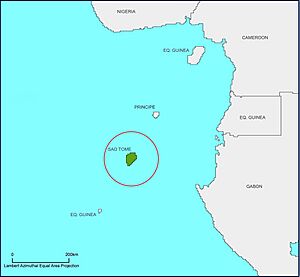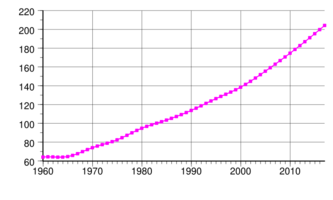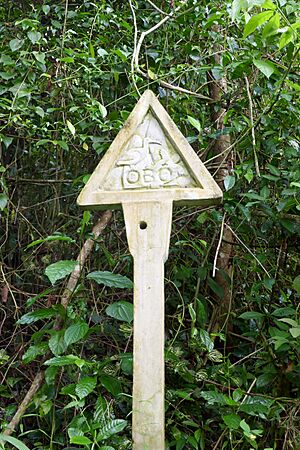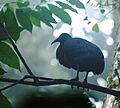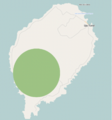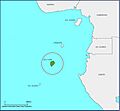São Tomé ibis facts for kids
Quick facts for kids São Tomé ibis |
|
|---|---|
 |
|
| Conservation status | |
| Scientific classification | |
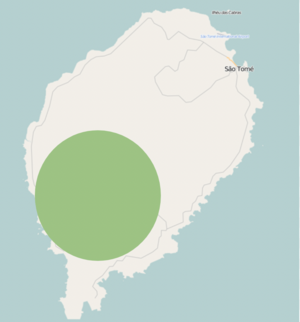 |
|
| Range map of the distribution of the dwarf ibis on the island of São Tomé |
The São Tomé ibis (Bostrychia bocagei) is a very rare bird. It is also called the dwarf olive ibis or the dwarf ibis. This bird lives only on São Tomé, an island near the west coast of Central Africa. It is found in the Gulf of Guinea.
Scientists first discovered this bird in the 1800s. For a while, they thought it was a type of the larger olive ibis. But now, they know it's its own special species. The dwarf ibis is one of 20 unique bird species on São Tomé. Sadly, 10 of these, including the ibis, are in danger of disappearing forever.
This ibis likes to live in the southern forests of the island. It builds its nests high in the trees to stay safe from animals that might hunt it. Besides hunters, the ibis is also threatened by people taking too many resources from the island. This causes its home to shrink. Even though there aren't specific plans just for the dwarf ibis, some efforts are helping all the wildlife on São Tomé. These include programs like ECOFAC and creating a national park.
Contents
What Does the São Tomé Ibis Look Like?
The São Tomé ibis is a small bird. Its wings are about 248 millimeters (almost 10 inches) long. Its beak is about 75 millimeters (3 inches) long. The bird's head is a dull olive color. It has black feathers around its eyes and at the base of its beak. The feathers on its wings and back have a slightly shiny, bronze look.
This ibis is usually quiet. But if something bothers it, it makes short, grunting sounds. When it goes to sleep for the night, it makes a loud honking noise. Some people describe its call as a stressed Walalalala.
How Does the São Tomé Ibis Behave?
The dwarf ibis builds its nests high up in trees. These nests are usually between 8 and 16 meters (26 to 52 feet) off the ground. The birds make their nests mostly from twigs and other plant bits. They line the inside with leaves and feathers to make it soft. These nests are about 330 to 370 millimeters (13 to 14.5 inches) wide and 260 to 360 millimeters (10 to 14 inches) deep.
Where Does the São Tomé Ibis Live?
The São Tomé ibis lives on the island of São Tomé. This island is located off the coast of Western Africa. It was first found by Francisco Newton in the late 1800s. The ibis prefers to live in the old, untouched forests below 450 meters (about 1,476 feet) in height. It is mostly seen in the southern parts of these forests.
The ibis builds its nests high in trees and away from running water. This helps it avoid predators like snakes and animals brought to the island by humans. These animals include rats and Mona monkeys. Recently, more ibises have been seen in the new Obô Natural Park. This park covers most of the western side of the island. The ibis looks for food on the forest floor where there isn't much undergrowth. It especially likes areas where wild pigs have dug up the ground. It also searches for food in swampy areas near streams.
Why is the São Tomé Ibis in Danger?
There are very few São Tomé ibises left. Scientists believe there are only between 50 and 249 of these birds. Because of this, it is listed as Critically Endangered on the IUCN Red List. This means it is at very high risk of disappearing forever. A similar type of ibis on the nearby island of Príncipe died out in the last century. This shows how small habitats can make ibises very vulnerable. The São Tomé ibis faces dangers from both human activities and environmental changes.
Human Activities
Since the 1500s, about 75% of São Tomé's natural plant life has been lost. This is due to human actions. The São Tomé ibis suffers from its home being destroyed, too much hunting, and cities growing. To build cities, people have cut down forests for roads and railroads. Dams are also being built for electricity.
A big problem is the growth of oil palm plantations. These are large farms where companies grow oil palm trees. Other farms for cacao, coffee, and spices have also taken over land. When these farms are built, the homes of all nearby wildlife are destroyed. This harms the dwarf ibis and other animals. These changes happen because more people are moving to the island. More people need more resources, which leads to more logging and less space for the ibis.
Hunting also plays a big role in why the dwarf ibis is endangered. This bird is large and looks for food on the forest floor. It is also not very afraid of humans, which makes it easy for hunters to catch. Whether hunted on purpose or killed by accident, the ibis population is shrinking.
Environmental Dangers
Besides human activities, there are also environmental dangers. These come from invasive species. These are animals that are not native to São Tomé but have been brought there. They can compete with the ibis for food or hunt them. Non-native predators include feral cats, feral dogs, Mona monkeys, black rats, least weasels, and African civets.
How Can We Help the São Tomé Ibis?
For a long time, not much research or conservation happened in the Gulf of Guinea. This was due to political problems and economic issues. People have talked about protecting São Tomé's wildlife for over 100 years. But real action only started about 40 years ago.
Conservation Efforts
In 1993, a group called the Gulf of Guinea Conservation Group was formed. They wanted to do more research and conservation. This group brought scientists to the islands to study the wildlife. At the same time, the European Commission started funding the ECOFAC program. This program helped pay for studies on São Tomé's wildlife and how to protect it. It also aimed to teach people how to use forest resources in a way that doesn't harm them. The ECOFAC program helped create the Bom Sucesso Botanical Garden. This garden is the entrance to the Obô National Park. While these efforts weren't just for the dwarf ibis, they have helped its population indirectly.
International groups are also getting involved. In 2018, BirdLife International opened an office in São Tomé. They have been helping with conservation and research since 2012. Since 2015, Fauna and Flora International has worked to build conservation skills and raise awareness about the environment.
The Obô National Park was created in 2006. This park protects the best-preserved forests, including most of the areas where the dwarf ibis breeds. Most of the ibis's land is now protected. However, people still illegally enter the park and take resources. For example, 5,000 tons of firewood were used in 2014. To truly help the ibis, local people need to understand that protecting nature also helps them. This idea is being developed on Príncipe island, but not yet on São Tomé.
In 2011, The Mohamed bin Zayed Species Conservation Fund gave $7,850 to help protect São Tomé's land and species. This study was important because there wasn't much information about the island's unique species before. It showed how important it was to tell people both inside and outside the country about the ibis. This helped raise awareness for the dwarf ibis.
In December 2021, the European Union started the Global Gateway plan. This plan helps developing countries build sustainable infrastructure. It also works with partners and private companies. Half of its €300 billion budget is going to Africa for conservation. Some of this money could help protect species like the dwarf ibis in the Gulf of Guinea.
Challenges for Conservation
Even with these efforts, no specific plan has been made just for the dwarf ibis. All conservation efforts have focused on general species or protecting plants.
To stop overhunting, habitat loss, and problems from tourism, it's a good idea to work directly with hunters and tourist companies. By working with the people who hunt the birds and controlling how tourists see them, the São Tomé ibis has a better chance of survival. Raising awareness about the dwarf ibis is important. This means getting people to care about it and spreading the word.
It's also important for local people to change their mindset. They need to shift from taking resources to protecting nature. This kind of cultural change is hard, but it's necessary to save the dwarf ibis and other species on the island.
Images for kids



